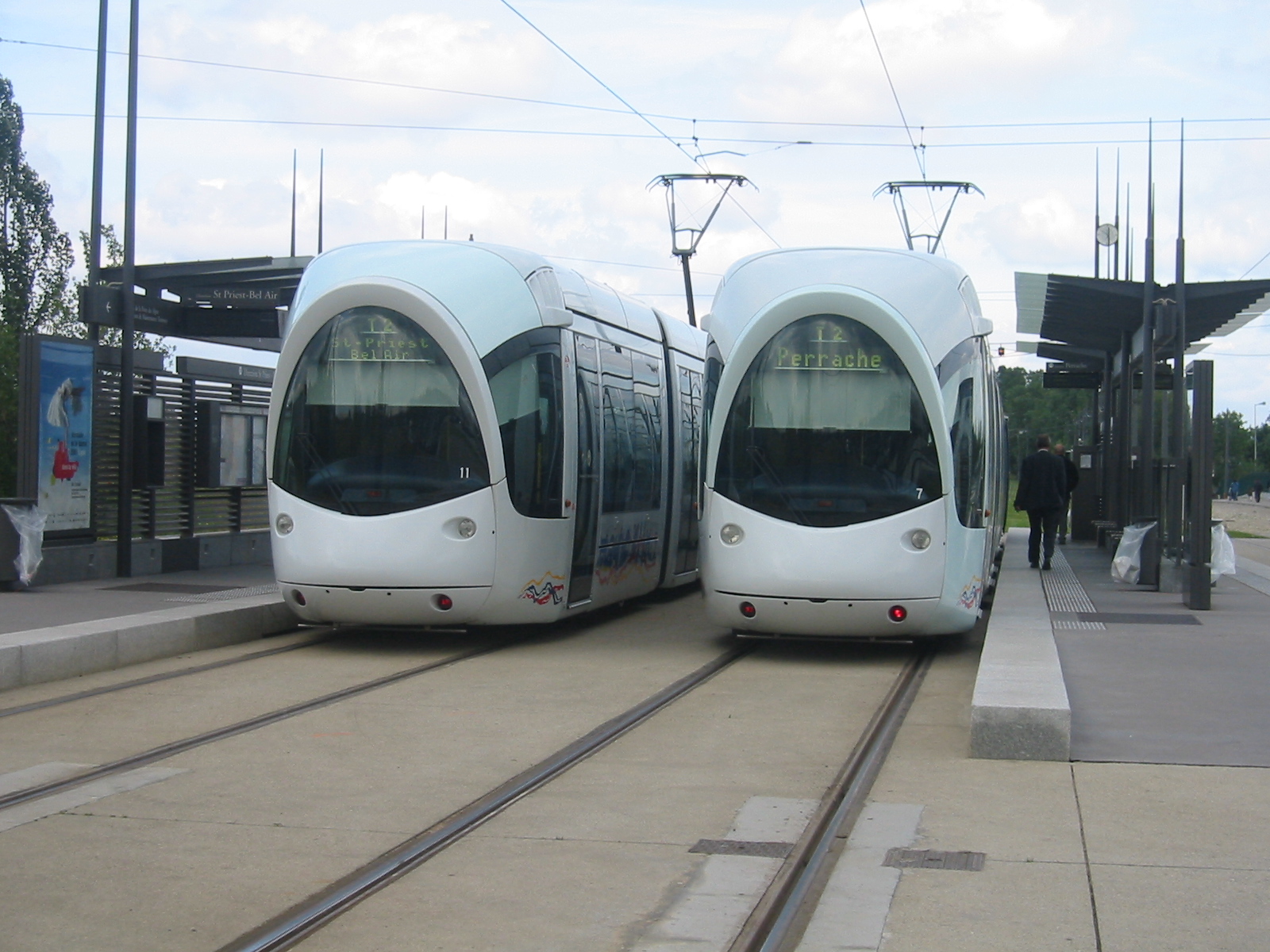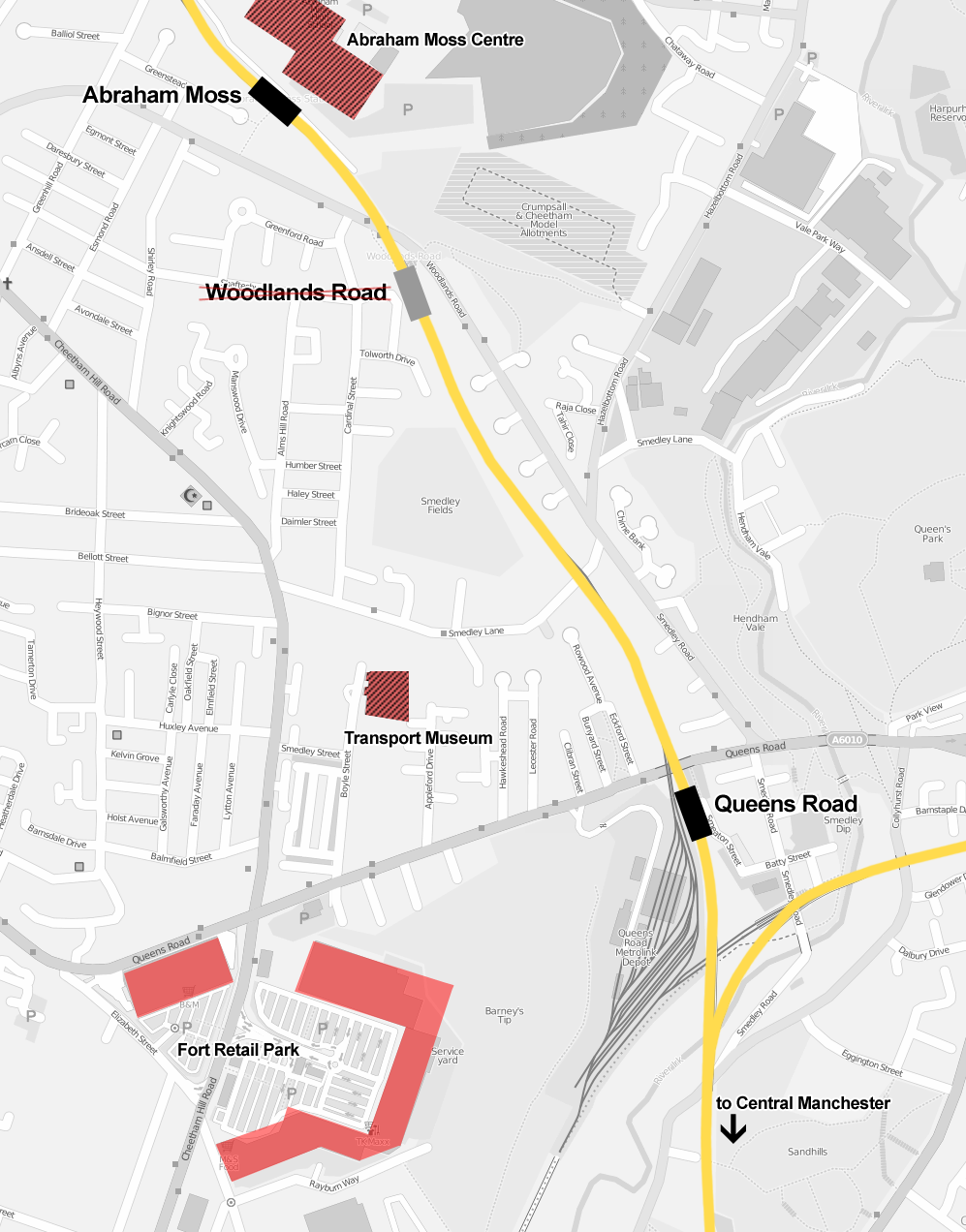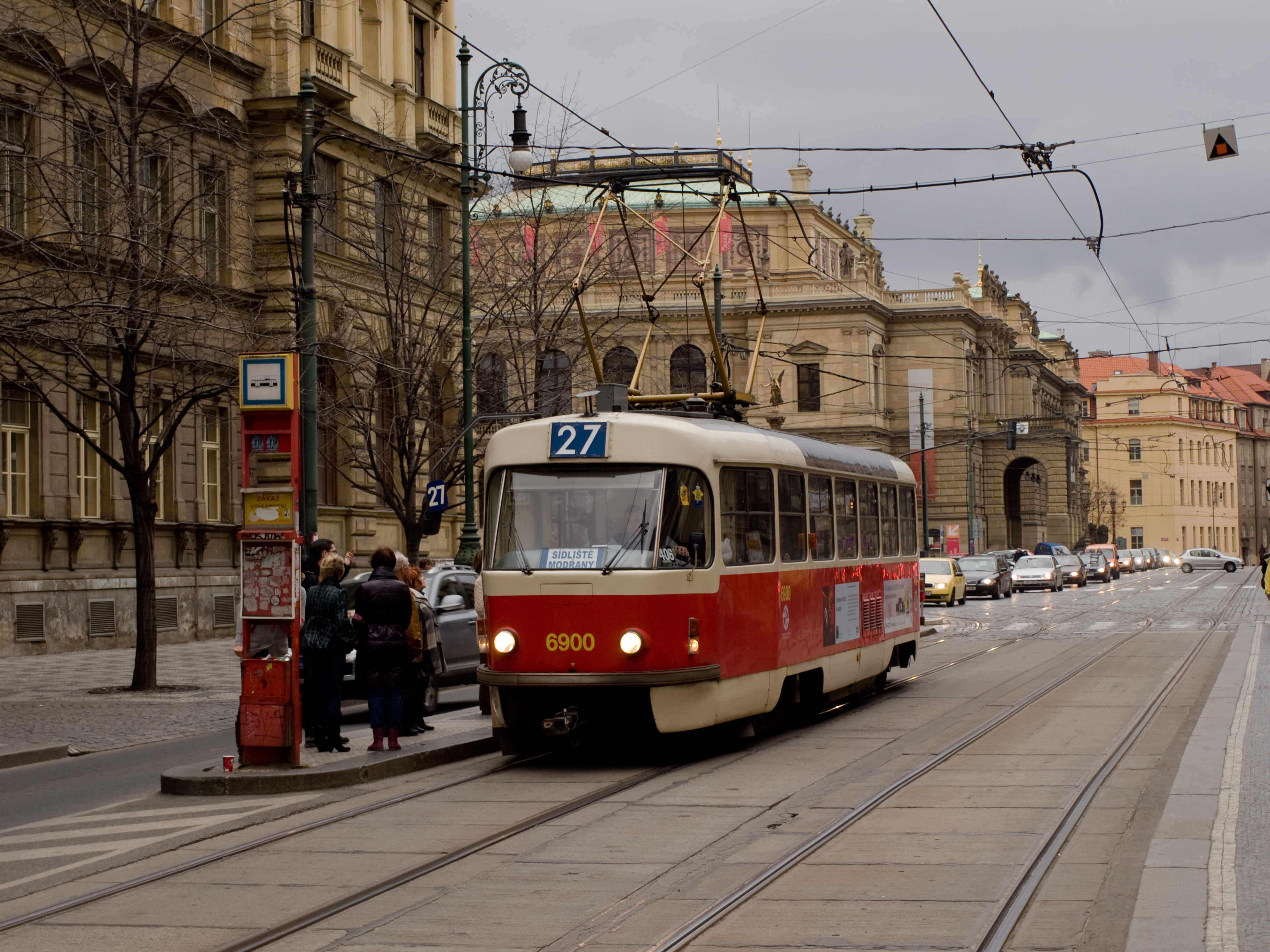|
Queens Road Tram Stop
Queens Road is a tram stop in the suburban area of Cheetham Hill, Greater Manchester, England. It is on the Bury Line of Greater Manchester's light rail Metrolink system. History It originally opened as a staff halt stop only, serving the Metrolink system's original Queens Road depot at Metrolink House. The station opened on 16 December 2013. Queens Road is the closest station to the Manchester Museum of Transport on Boyle Street and is adjacent to the Irish World Heritage Centre. The station replaced Woodlands Road tram stop Woodlands Road was a tram stop on the Bury Line of the Metrolink system in the Cheetham Hill area of north Manchester, England. It opened in 1913 as a heavy rail station and closed for conversion to light rail in 1991, opening with the new M ..., which closed on the opening day of Queens Road tram stop to passengers. Services Services mostly run every 12 minutes on 2 routes, forming a 6-minute service between Bury and Manchester at peak times. ... [...More Info...] [...Related Items...] OR: [Wikipedia] [Google] [Baidu] |
Manchester Metrolink
Manchester Metrolink (branded locally simply as Metrolink) is a tram/ light rail system in Greater Manchester, England. The network has 99 stops along of standard-gauge route, making it the most extensive light rail system in the United Kingdom. Metrolink is owned by the public body Transport for Greater Manchester (TfGM) and operated and maintained under contract by a Keolis/ Amey consortium. In 2021/22, 26 million passenger journeys were made on the system. The network consists of eight lines which radiate from Manchester city centre to termini at Altrincham, Ashton-under-Lyne, Bury, East Didsbury, Eccles, Manchester Airport, Rochdale and Trafford Centre. It runs on a mixture of on-street track shared with other traffic; reserved track sections segregated from other traffic, and converted former railway lines. Metrolink is operated by a fleet of 147 high-floor Bombardier M5000 light rail vehicles. Each service runs to a 12-minute headway; stops with more than one serv ... [...More Info...] [...Related Items...] OR: [Wikipedia] [Google] [Baidu] |
Cheetham Hill
Cheetham is an inner-city area and electoral ward of Manchester, England, which in 2011 had a population of 22,562. It lies on the west bank of the River Irk, north of Manchester city centre, close to the boundary with Salford, bounded by Broughton to the north, Harpurhey to the east, and Piccadilly and Deansgate to the south. Historically part of Lancashire, Cheetham was a township in the parish of Manchester and hundred of Salford. The township was amalgamated into the Borough of Manchester in 1838, and in 1896 became part of the North Manchester township. Cheetham is home to a multi-ethnic community, a result of several waves of immigration to Britain. In the mid-19th century, it attracted Irish people fleeing the Great Famine. It is now home to the Irish World Heritage Centre. Jews settled in the late-19th and early-20th centuries, fleeing persecution in continental Europe. Migrants from the Indian subcontinent and Caribbean settled in the 1950s and 1960s, and more ... [...More Info...] [...Related Items...] OR: [Wikipedia] [Google] [Baidu] |
Manchester
Manchester () is a city in Greater Manchester, England. It had a population of 552,000 in 2021. It is bordered by the Cheshire Plain to the south, the Pennines to the north and east, and the neighbouring city of Salford to the west. The two cities and the surrounding towns form one of the United Kingdom's most populous conurbations, the Greater Manchester Built-up Area, which has a population of 2.87 million. The history of Manchester began with the civilian settlement associated with the Roman fort ('' castra'') of ''Mamucium'' or ''Mancunium'', established in about AD 79 on a sandstone bluff near the confluence of the rivers Medlock and Irwell. Historically part of Lancashire, areas of Cheshire south of the River Mersey were incorporated into Manchester in the 20th century, including Wythenshawe in 1931. Throughout the Middle Ages Manchester remained a manorial township, but began to expand "at an astonishing rate" around the turn of the 19th century. Manchest ... [...More Info...] [...Related Items...] OR: [Wikipedia] [Google] [Baidu] |
Bury Line
The Bury Line is a tram line of the Manchester Metrolink running from Manchester city centre to Bury in Greater Manchester. Originally a railway line, it was, along with the Altrincham Line, converted into a tram line during 1991–92, as part of the first phase of the Metrolink system. The line runs entirely on an old railway alignment without any street running. It runs north from and connects the suburbs of Cheetham Hill, Prestwich, Whitefield and Radcliffe. The entire route from Victoria to Bury is roughly long. Two services travel along the line, both starting at Bury, and terminating at and respectively. History Pre-Metrolink The line was originally heavy rail. The first part of what is now the Bury Line was opened by the East Lancashire Railway (ELR) in 1846, From to via Salford, Clifton Junction and Radcliffe, continuing north from Bury to Rawtenstall. The ELR was absorbed into the Lancashire and Yorkshire Railway (L&YR) in 1859. The second part was opened in ... [...More Info...] [...Related Items...] OR: [Wikipedia] [Google] [Baidu] |
Tram Stop
A tram stop, tram station, streetcar stop, or light rail station is a place designated for a tram, streetcar, or light rail vehicle to stop so passengers can board or alight it. Generally, tram stops share most characteristics of bus stops, but because trams operate on rails, they often include railway platforms, especially if stepless entries are provided for accessibility. However, trams may also be used with bus stop type flags and with mid-street pavements as platforms, in street running mode. Examples Most tram or streetcar stops in Melbourne and Toronto and other systems with extensive sections of street-running have no associated platforms, with stops in the middle of the roadway pavement. In most jurisdictions, traffic cannot legally pass a tram or streetcar whose doors are open, unless the tram is behind a safety zone or has a designated platform. On the other hand, several light rail systems have high-platform stops or stations with dedicated platforms at railway ... [...More Info...] [...Related Items...] OR: [Wikipedia] [Google] [Baidu] |
Greater Manchester
Greater Manchester is a metropolitan county and combined authority, combined authority area in North West England, with a population of 2.8 million; comprising ten metropolitan boroughs: City of Manchester, Manchester, City of Salford, Salford, Metropolitan Borough of Bolton, Bolton, Metropolitan Borough of Bury, Bury, Metropolitan Borough of Oldham, Oldham, Metropolitan Borough of Rochdale, Rochdale, Metropolitan Borough of Stockport, Stockport, Tameside, Trafford and Metropolitan Borough of Wigan, Wigan. The county was created on 1 April 1974, as a result of the Local Government Act 1972, and designated a functional Manchester City Region, city region on 1 April 2011. Greater Manchester is formed of parts of the Historic counties of England, historic counties of Cheshire, Lancashire and the West Riding of Yorkshire. Greater Manchester spans , which roughly covers the territory of the Greater Manchester Built-up Area, the List of urban areas in the United Kingdom, second most ... [...More Info...] [...Related Items...] OR: [Wikipedia] [Google] [Baidu] |
Manchester Museum Of Transport
The Museum of Transport, Greater Manchester aims to preserve and promote the public transport heritage of Greater Manchester in North West England. It is located in the Cheetham Hill area of Manchester. Background The museum was established in 1977 at Boyle Street, Cheetham Hill. It opened to the public on 27 May 1979. The day-to-day running of the museum is carried out by volunteers. The museum is housed in a former Manchester Corporation Transport bus depot, to the rear of a former electric tram shed on Queens Road, built in 1901. The museum building itself was added later and consists of two distinct halves, a dedicated bus garage completed in 1928, which now serves as the museum entrance area and upper hall, and a lower hall which was created in 1935 by constructing a roof over the open space between the tram shed and the 1928 bus depot. The former tram shed is still in use today as a bus depot, occupied by Go North West. The whole block of buildings was Grade II listed in ... [...More Info...] [...Related Items...] OR: [Wikipedia] [Google] [Baidu] |
Woodlands Road Tram Stop
Woodlands Road was a tram stop on the Bury Line of the Metrolink system in the Cheetham Hill area of north Manchester, England. It opened in 1913 as a heavy rail station and closed for conversion to light rail in 1991, opening with the new Metrolink system in 1992. Woodlands Road was the closest station to the Manchester Museum of Transport on Boyle Street. Two new stations opened nearby, ( and ), which led to the closure of the stop on 16 December 2013. History The original railway line was opened in 1879 by the Lancashire and Yorkshire Railway between Manchester Victoria and Bury. Woodlands Road, and stations were added to the line in 1913, in an attempt to fend off growing electric tramway competition in the Cheetham Hill area. The original halt had wooden platforms. The site is near the vanished junction of a former branch line to the chemical works in Blackley. Closure The UK Government announced that £4 million from the Community Infrastructure Fund was awarded ... [...More Info...] [...Related Items...] OR: [Wikipedia] [Google] [Baidu] |
Tram Stops In Manchester
A tram (called a streetcar or trolley in North America) is a rail vehicle that travels on tramway tracks on public urban streets; some include segments on segregated right-of-way. The tramlines or networks operated as public transport are called tramways or simply trams/streetcars. Many recently built tramways use the contemporary term light rail. The vehicles are called streetcars or trolleys (not to be confused with trolleybus) in North America and trams or tramcars elsewhere. The first two terms are often used interchangeably in the United States, with ''trolley'' being the preferred term in the eastern US and ''streetcar'' in the western US. ''Streetcar'' or ''tramway'' are preferred in Canada. In parts of the United States, internally powered buses made to resemble a streetcar are often referred to as "trolleys". To avoid further confusion with trolley buses, the American Public Transportation Association (APTA) refers to them as "trolley-replica buses". In the United ... [...More Info...] [...Related Items...] OR: [Wikipedia] [Google] [Baidu] |
Railway Stations In Great Britain Opened In 2013
Rail transport (also known as train transport) is a means of transport that transfers passengers and goods on wheeled vehicles running on rails, which are incorporated in tracks. In contrast to road transport, where the vehicles run on a prepared flat surface, rail vehicles (rolling stock) are directionally guided by the tracks on which they run. Tracks usually consist of steel rails, installed on sleepers (ties) set in ballast, on which the rolling stock, usually fitted with metal wheels, moves. Other variations are also possible, such as "slab track", in which the rails are fastened to a concrete foundation resting on a prepared subsurface. Rolling stock in a rail transport system generally encounters lower frictional resistance than rubber-tyred road vehicles, so passenger and freight cars (carriages and wagons) can be coupled into longer trains. The operation is carried out by a railway company, providing transport between train stations or freight customer facil ... [...More Info...] [...Related Items...] OR: [Wikipedia] [Google] [Baidu] |
Tram Stops On The Altrincham To Bury Line
A tram (called a streetcar or trolley in North America) is a rail vehicle that travels on tramway tracks on public urban streets; some include segments on segregated right-of-way. The tramlines or networks operated as public transport are called tramways or simply trams/streetcars. Many recently built tramways use the contemporary term light rail. The vehicles are called streetcars or trolleys (not to be confused with trolleybus) in North America and trams or tramcars elsewhere. The first two terms are often used interchangeably in the United States, with ''trolley'' being the preferred term in the eastern US and ''streetcar'' in the western US. ''Streetcar'' or ''tramway'' are preferred in Canada. In parts of the United States, internally powered buses made to resemble a streetcar are often referred to as "trolleys". To avoid further confusion with trolley buses, the American Public Transportation Association (APTA) refers to them as " trolley-replica buses". In the Un ... [...More Info...] [...Related Items...] OR: [Wikipedia] [Google] [Baidu] |






